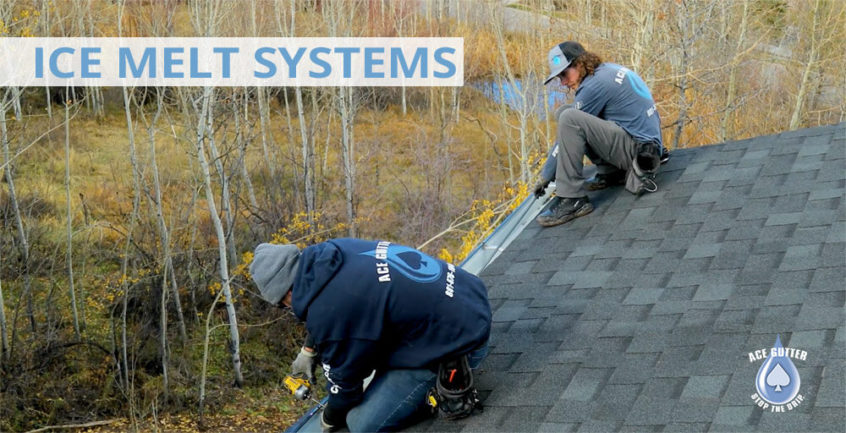According to the Winter 2021-2022 Outlook, most areas in Utah will experience about average snowfall this season. Is your home ready? While many homes in the valleys and lower elevations may not have a need, homes along the benches from Provo to Salt Lake, Bountiful, Farmington and Ogden will. In addition, cities like Park City, Heber City, and Morgan will have a need for ice melt systems.
There are several ways to keep your roof clean during the winter. However, investing in heat tape gutters is probably your best shot at getting rid of the snowy build-up without breaking a sweat.
If you haven’t heard of heat tape cable before, you’re probably wondering what it is and how it can benefit you. In this post, we’ll delve into the basics of these ice melt roof systems, starting with what they are.
What is Heat Tape?
A heat tape is a protected cable or cord that you can attach to pipes, rain gutters, and the roof. Heat tape is sometimes called ice melt roof systems or heat tape gutters.
These systems are essentially nothing more than resistive heaters that heat up when the electricity passes through them.
Most heat tape come with an in-built thermostat to control the temperature and heating cycles. When installed on roofs and gutters, they prevent ice dam build-up during the winters.
Heat Tape for Pipes v/s Heating Cable for Roofs: The Similarities and Differences
Although the terms ‘heat tape for pipes’ and ‘heat cables for roofs’ sound similar, they have a few distinct differences. For starters, ice melt roof systems have rounded cords. This design provides maximum surface area for better heat distribution.
On the other hand, heat tape for water pipes are flat, making it easier to wrap them around pipes. It also facilitates heat transfer, keeping your water pipes from bursting during extreme cold.
Heat gutter tape and cables come in different lengths. You can buy one depending on the size of your roof. Also, the ice melt roof systems are usually not pre-wired. You will have to attach them to a controller and a plug.
Heat tape for pipes usually have fixed lengths and are pre-wired. Just wrap them around the pipes, plug them in, and you are all set.
But there is one similarity – they are both a type of resistive heater. Also, you can control the temperature and heating cycles depending on the application. It protects the cables or tape from overheating.
How Does Heat Tape Work?
As mentioned before, heat tape gutters are resistive heaters. When electricity passes through the tape, its resistivity generates heat, warming up the ice roof melting systems.
Using a controller, you can maintain the desired temperature. Usually, the system will have temperature control between 450 to 500 degrees Fahrenheit. However, you can get roof heating cables with a higher temperature range if required.
Benefits of Installing Heat Tape
Heat tape gutters can offer you several benefits. Some of the most common ones include the following.
- Prevent Ice Dam Formation
Ice dams form on heated houses or buildings with sloped roofs. This happens as the roof develops cold and warm areas. Usually, the heating system (HVAC) doesn’t reach the eaves, so they remain below freezing point during the winter.
However, the snow from the rest of your roof continues to melt due to the building heat. This causes the meltwater to flow down and accumulate near the eaves, creating ice dams.
Thanks to ice melt roof systems, you can minimize the risk of ice dam buildup. However, these systems won’t stop ice dams from forming altogether. They only provide the meltwater a way to flow down the roof.
- Protect Your Roof
Ice dams put extreme pressure on the roof. Sometimes, the pressure can be high enough to break your roof down. And it will also cause the trapped meltwater to leak through the roof, into the ceiling, insulation, and the walls. That, in turn, will most likely lead to a plethora of problems, including:
- Mildew, mold formation, and rot
- Damage to the insulation of your drywall
- Poor indoor air quality
Heat tape gutters can protect your roof from this damage. It’s a small investment that can go a long way in saving money on roof repairs.
- Makes Your Gutters More Efficient
Your roof may be strong enough to hold a few inches of snow, but your rainwater gutters often aren’t. If the snow accumulates in your gutters, it’ll probably break them down, destroying the appearance of your lovely home.
Thanks to heat tape gutters, you need not worry about this damage. If anything, this simple trick will improve the efficiency of your rainwater gutters. And yes, your external walls will stay as beautiful as ever.
- Prevent Potential Accidents and Injuries
The snow gathering on the eaves and in rain gutters is an accident waiting to happen. It is highly likely to get too heavy and fall on people passing by or standing under it. Plus, the ice will keep refreezing in your driveway, turning it into a slippery slope.
Unless you want to deal with an accident, you should keep the snow in check. That’s another benefit of having heat tape gutters. They will make sure the snow melts and flows through the desired path, keeping everyone, including your family, safe.
Disadvantages of Using Heat Tape
As great as heat tape sound, they are not all roses. There are a few downsides to installing ice melt roof systems on your roof. You should know about them to make an informed decision.
- It’s Not the Prefect Solution
Heat tape gutters can reduce the risk of ice dams, not eliminate the problem. You can lay the cable the best way possible. Still, ice dams will form in one place or another. So be prepared to understand this limitation fully before deciding.
- Higher Energy Bills
The third disadvantage is higher energy bills. As heat tape gutters are electric-powered, your energy bills will go up during the winter. And if the winter extends, you will pay more money toward energy costs. However, heat tape is still a good idea as this cost is negligible compared to getting your roof repaired.
How to Choose the Right Type of Heat Tape for Your Roof
Heat tape come in all shapes and sizes, so you will have to choose one that best fits your needs and budget. You will need to consider the following factors.
- Monitoring: If you want minimal monitoring, self-regulated heat tape would be the best option. This tape will change its heat output depending on the surrounding temperature. You can get it custom fit as per your requirement.
If you are looking for a slightly cheaper alternative, you can go for non-self-regulated heat tape. However, these heat tape gutters require constant monitoring. But remember, you will have to buy a connector and plug separately for both.
- Functionality: If you are an energy-conscious homeowner, you would want to buy heated water hoses. They use running hot water to prevent ice dams. These ice melt roof systems also come in varying lengths. They will keep your energy bills reasonable.
Another alternative is to buy automatic electric heat cables. They come with an in-built thermostat which can help lower your electricity bills. They also come in multiple lengths.
Installing Heat Tape: Should You Do It Yourself?
As you can see, installing ice melt roof systems can go a long way in keeping your home safe. The question is, should you do it yourself or hire a professional roofing company to do it. If you are a DIY enthusiast, you can do it yourself.
However, you do need to consider several factors. For example, you will have to make sure your gutters are up for this challenge. Also, the tape should not move over itself because that’ll lead to short circuits. And your home electrical system should be able to handle the added load of heat tape gutters.
If you can’t work these things out yourself, you are better off hiring a professional. Most gutter cleaning service providers also offer these services. It’s a good idea to ask local experts if they can do it.
In Conclusion
Ice melt roof systems are simple heating devices that can save your roof from catastrophic damage during the winter. They prevent ice dams from damaging your roof, ceiling, and walls, making sure your family is safe. If you are a Utah resident, you can’t do away with roof heat tape. Hopefully, this short guide will help you choose the best roof heating system for your home.
If you still have questions or need help with heat tape gutters installation, Ace Gutter is here to help. Our experts can help you make an informed decision for all things related to the health of your roof. Call at (801) 676-1048 or fill out our secure online contact form today.


